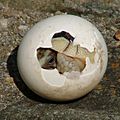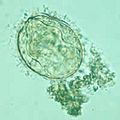Egg facts for kids
An egg is like a special package that holds a new life. It's often round or oval and has a protective shell. Many animals, like birds, reptiles, fish, and insects, lay eggs. Eggs provide food and protection for the growing baby animal inside. Humans also eat eggs from some animals, like chickens, as a healthy food.
Contents
Eggs in Biology
What is an Egg?
In biology, an egg is a female reproductive cell. It's also called an ovum. This tiny cell contains all the genetic information from the mother. It's ready to combine with a male reproductive cell to start a new life.
How a New Life Begins
When an ovum is fertilized by a male cell, it becomes a zygote. This zygote is the very first stage of a new living thing. It will then start to divide and grow into an embryo.
Different Kinds of Eggs
Many animals lay eggs outside their bodies. These eggs are designed to protect and feed the developing embryo.
Cleidoic Eggs
Some animals, like reptiles, birds, and some mammals, lay a special kind of egg called a cleidoic egg. These eggs have a hard or leathery shell. Inside, they have membranes that protect the embryo. They also have a yolk for food and a space for waste. This design helps the embryo grow safely on land.
Eggs in Water
Animals like fish and frogs lay their eggs in water. These eggs usually have a soft, jelly-like coating. They don't need a hard shell because the water protects them. The water also keeps them from drying out.
Insect Eggs
Insects lay many different kinds of eggs. They can be tiny and laid on leaves or in the ground. Some insect eggs are very well hidden. They are designed to protect the developing insect larvae.
Eggs as Food
Eggs from certain animals are a popular food for humans. The most common eggs we eat come from chickens. But people also eat eggs from ducks, geese, and quails.
What's Inside a Food Egg?
A chicken egg has a hard shell on the outside. Inside, there's the egg white (albumen) and the egg yolk. The yolk is the yellow part. It's full of nutrients like protein, vitamins, and minerals. The egg white is mostly protein and water.
How We Use Eggs
Eggs are used in many ways in cooking. We can scramble them, fry them, or boil them. They are also a key ingredient in baking. Eggs help to bind ingredients together. They also make cakes and breads light and fluffy.
Egg Safety
It's important to handle eggs safely. Always keep them in the refrigerator. Cook them thoroughly to avoid any germs. This makes sure they are safe and healthy to eat.
Images for kids
-
Eggs of various birds, a reptile, various cartilaginous fish, a cuttlefish and various butterflies and moths. (Click on image for key)
-
Salmon fry hatching. The larva has grown around the remains of the yolk and the remains of the soft, transparent egg are discarded.
-
Turtle eggs in a nest dug by a female common snapping turtle (Chelydra serpentina)
-
Orange-peel doris (Acanthodoris lutea), a nudibranch, in tide pool laying eggs
-
Microlecithal eggs from the roundworm Toxocara
-
Microlecithal eggs from the flatworm Paragonimus westermani
-
Frogspawn is mesolecithal.
-
A baby tortoise begins to emerge "fully developed" from its macrolecithal egg.
-
Chocolate Easter eggs hidden as part of an egg hunt
-
An average whooping crane egg is 102 mm (4.0 in) long and weighs 208 g (7.3 oz)
-
Egg of a senegal parrot, a bird that nests in tree holes, on a 1 cm (0.39 in) grid
-
Finch egg next to American dime
-
Eggs of duck, goose, guineafowl and chicken
-
Egg of an emu
-
Egg from a chicken compared to a 1 euro coin, great tit egg and a corn grain
-
Insect eggs, in this case those of the Emperor gum moth, are often laid on the underside of leaves.
-
Fish eggs, such as these herring eggs are often transparent and fertilized after laying.
-
A Testudo hermanni emerging fully developed from a reptilian egg.
-
Eggs of Huffmanela hamo, a nematode parasite in a fish
See also
 In Spanish: Huevo (biología) para niños
In Spanish: Huevo (biología) para niños






























